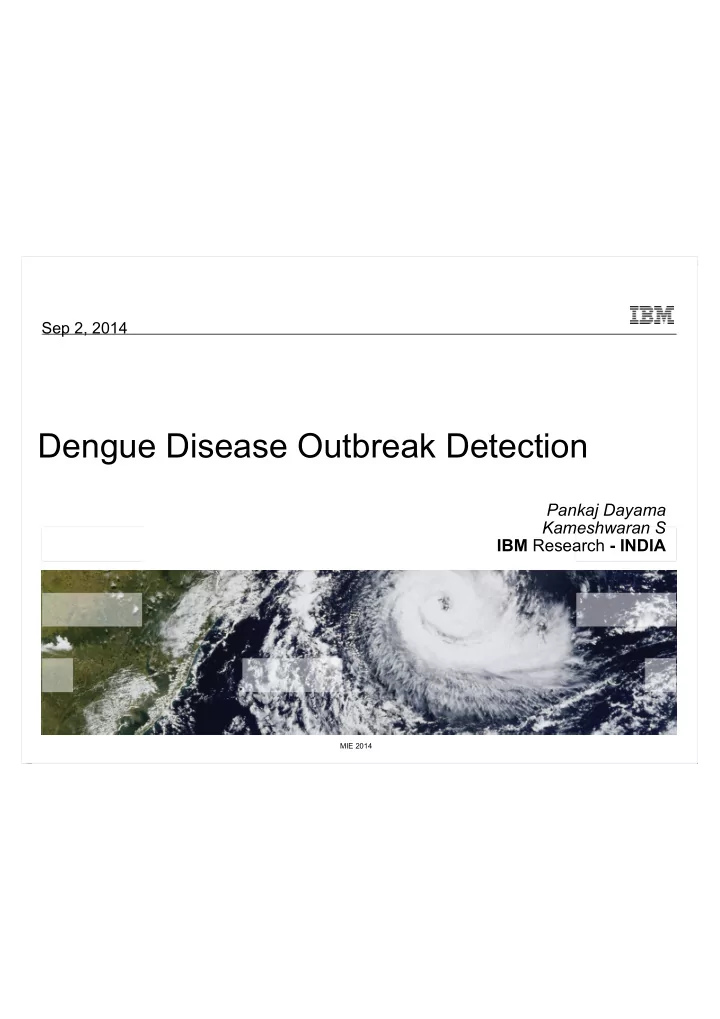

Sep 2, 2014 Dengue Disease Outbreak Detection Pankaj Dayama Kameshwaran S IBM Research - INDIA MIE 2014
Outline ● Background ● Dengue Transmission Dynamics ● Proposed Approach ● Results ● Future Directions MIE 2014
Dengue ● Dengue is a major international public health concern – endemic in more 100 countries in Asia, Latin America, Africa, and Western Pacific. ● Around 40% of the world population is at risk from Dengue: 50 – 100 million cases of infections annually ● Dengue has annual seasonality and the epidemics follow a quasi-periodicity of 4-7 years for large epidemic outbreaks ● There is NO treatment and NO vaccination MIE 2014
Transmission Dynamics Dengue&is&a&mosquito&borne&infec2ous&disease Suscep/ble&Mosquito&Bite Infectious Latent Pa/ent&2 5 Days Intrinsic Incubation Recovery 4-7 Days 3-10 Days Infec/ous&Mosquito&Bite Extrinsic Incubation Infectious 8-12 Days 2 – 4 Weeks Suscep/ble&Mosquito&Bite Infectious Latent 5 Days Pa/ent&1 Intrinsic Incubation Recovery 4-7 Days 3-10 Days Infec/ous Onset&of Symptoms Mosquito&Bite Symptoms Stop
Transmission Dynamics ● Four similar but distinct serotypes of Dengue viruses HOST VECTOR -Seroprevalence - Aedes burden ● Immunity and Cross-immunity: - Cross immunity - Biting rate – Life-long immunity from serotype of primary infection (usually DF) VIRUS – Partial cross-immunity to other three - Serotype serotypes - Multiplication – Secondary infection results in DHF and -Shedding DSS (high mortality rate) • Weather influences vector and viral characteristics (short term influences) Prevention & Control • Host features and serotype change over a long period of time ● Source reduction • Vector and viral characteristics cannot be – Killing of mosquitoes or larvae or eggs directly observed ( Hidden ) • Host characteristics can only be statistically ● Isolating infected humans inferred with sampling ( Incomplete ) Aedes%Life%Cycle Week 1 Week 2 Week 3 Egg hatches Pupa Mosquito 1007Eggs 1007Eggs 1007Eggs 1007Eggs on Larvae contact with water MIE 2014
Periodicity of Outbreaks and Serotype Predominance ● Co-circulation of multiple virus serotypes in Singapore - hyperendemicity ● Dengue characterized by cycle of 3 - 4 years, increased incidence within a cycle followed by lull of 1-2 years. ● Quasi-periodicity attributed to intrinsic epidemic dynamics and not on climatic factors MIE 2014
Dengue Incidence – Yearly MIE 2014
Existing Approach Source: MOH (Singapore). Weekly Infectious Diseases Bulletin. Singapore: Ministry of Health. • Compute moving average and standard deviation of DI (past 5 years) • Warning Threshold = µ + 1 σ • Epidemic Threshold = µ + 2 σ Shortcomings: • Seasonal Fluctuation and correlation in DI series ignored • Dengue cases reporting delays ignored MIE 2014
Proposed Approach Aggregation Methods: Majority Unanimity At least One (YES) (NO) (YES) Generalized Percen&le(Based Robust(Control Shewart(Chart Threshold Charts Seasonality captured Non-parametric, Time Series filtering by fitting weekly weekly threshold set procedure (SARIMA) + distributions to M percentile for DI Statistical surveillance based on historical method (EWMA) data MIE 2014
Results Outbreak Prediction: Test Period (2005-2006) Outbreak Prediction: Test Period (2011-2013) MIE 2014
Current Work: Alternate Perspective What is the current level of epidemic severity? Traditional Hidden Markov Models • 2 Levels • User defined Multiple Levels • Mean and SD of Incidence for each Level
Using Hidden Markov Models ● Severity levels for 2014 ● HMM is trained on weekly incidence from 2000 - 2013
Thanks kameshwaran.s@in.ibm.com MIE 2014
Recommend
More recommend